John Byron
Yup, I’m a real bonefish beginner.
Been chasing bonefish for just 3 years. Half-dozen trips. Lifetime of fly fishing and fly tying, couple decades in Florida saltwater, but new to bonefish. Thanks to some patient guides, I’ve caught a fair number. But not as many as I want and not as big as some I’ve lost. You’ll see me on the flats.
As a buddy says, “when you’re fishing, you’re learning.” These are some of the things I think I’ve learned.
The Fish
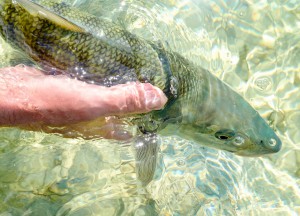 Bonefish prove evolution. Their entire genome is built around two imperatives:
Bonefish prove evolution. Their entire genome is built around two imperatives:
- Find lunch.
- Don’t become lunch.
- A year and a half ago I was in the room with the late great Lefty Kreh as he held forth in a day-long session at our fly-fishing club.
One of the members asked this question: “Lefty, you’ve fished the whole world, for just about every gamefish there is. If you could only fish for one species, what would it be?”
Lefty paused a few seconds and then gave his answer. “Bonefish!”
Fishing
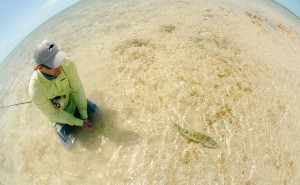 Beginners catch fish! Go to any good lodge (nearly all are) with any decent guide (nearly all are) and you will get shots and you will catch fish. On a decent first day with typical luck fishing, you will see backing flying through the guides.
Beginners catch fish! Go to any good lodge (nearly all are) with any decent guide (nearly all are) and you will get shots and you will catch fish. On a decent first day with typical luck fishing, you will see backing flying through the guides.
- Get the right fly in front of them the right way and bonefish will hoover it up with no hesitation. Chase it, even. Fight to see which fish gets the fly.
- Or … splash too much wading, line the fish, false cast once too often, hit the fish on the head with your fly, and the fish won’t wait around to see if you’re a barracuda or an osprey … it’s gone.
- Your learning efforts should go to getting more shots and blowing less of them.
- Catching bonefish is easy.
- Catching bonefish is hard.
- The flats give you time to think. And yes, you will see barracudas and sharks. Turtles. Rays. And if you squint hard enough, more different kinds of little critters than you ever knew existed. Bonefish flats teem with life.
- The right books will improve your luck:
- The basics: Dick Brown’s Fly Fishing for Bonefish; Chico Fernandez’s Fly-fishing for Bonefish.
- Best for fly patterns: Dick Brown’s Bonefish Fly Patterns.
- Best for seeing life through a bonefish’s eyes: Aaron Adams Fly Fisherman’s Guide to Saltwater Prey (noting that Chico has some good stuff from Aaron in his book too).
- There’s a ton of good writing and videos online too, on every aspect of bonefishing.
- Check out windfinder.com for the likely conditions where you’re going. You’ll learn the weather and wind patterns if you look at the website daily in the weeks before your trip.
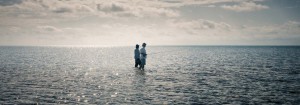 You’re likely to catch more fish wading than from a boat.
You’re likely to catch more fish wading than from a boat.
- But you can’t wade everywhere.
- Soft bottom is treacherous. Be careful.
- And the farther you wade, the farther it is back to the boat.
- You’ll prefer sun to cloud shadows. Watch the clouds for breaks and really scan hard when the sun comes out. Morning and afternoon, looking with the sun at your back is ideal (lunchtime most places, it’s pretty much overhead).
- Look for dark shapes, shadows, flashes, tails, nervous water, a push ahead of fish, a big troubled patch of water in the distance.
- Look for fish close, mid-distance, and way out there. I’ve seen schools at a quarter mile … and missed fish ten feet away. Ghost of the flats? You betcha.
- Take a 360-degree scan fairly often.
- The fish will often be coming towards you. Think about it: if they were going away, you’d never see ‘em.
- Should you move or let the fish come to you? If you’re wading at a half-mile an hour (typical), crude sweep-rate calculation tells you that a fish cruising at 5 mph is 10 times more likely to run into you than you are to bump into the fish.
- But wading slowly across the flat or in a poled boat takes you to channels and feeding places you might not ever encounter if you just stayed in one spot.
- I try to be kind to myself, go slow, but move along.
- A light drag is best. Your first hookup will show you why.
- Manage your line wading and in the boat.
- Learn to clear the line when you hook one. A three-pound fish will part a 15-pound leader effortlessly if you’ve wrapped the line around the rod butt.
- Train yourself to strip-set the hook. A trout-set will lose fish every time. And the guide will yell and everyone else will laugh at you.
- Landing the fish:
- Keep the fish in the water!
- Don’t touch the fish if you can get the hook loose without — barbless makes that easy.
- Sun gloves and dry hands wipe protective slime off the fish. Wet your bare hands first.
- Picture? Have the camera all ready, lift the fish with two hands, put it back in the water while it’s still dripping. 10 seconds should do it, 15 max.
- Boga-grips and other lip-holds are verboten.
- Slack the line:
- If a shark or barracuda is chasing the fish.
- If the fish winds its way through mangroves (and then walk slowly along your line to untangle it — amazingly, the fish may just sit there and wait for you).
Casting & Presentation
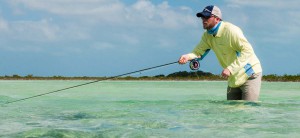 How you present your fly to the fish is the number one factor in how well you do. Good casting really matters.
How you present your fly to the fish is the number one factor in how well you do. Good casting really matters.- You usually don’t have to cast far to catch a bonefish.
- Short-range accuracy and speedy reaction are much more important than range.
- Most presentations will be inside 60 or 70 feet (from the reel, leader included) and many much closer than that.
- Keep the slack out of your line!
- If the fish are coming at you on a steady track, you may want to get the fly in the water ahead of them and let them run up to it before you start stripping.
- Short strips pop-pop-pop, slow strips, a bit faster if the fish is chasing you fly.
- There are two times to set the hook. Too early. And too late. You’ll do both.
- It’s not as bad as tarpon, but you will lose fish regularly. Goes with the game.
- Besides personal skill, two factors will affect your casting.
- Buck fever (trust me).
- And wind. You will be fishing in wind. Not all bad — the fish relax a bit when the surface is ruffled.
- How to improve your casting? Three steps:
- One: watch the videos online.
- Two: read a good casting book (George Roberts’ Master the Cast is excellent).
- Three: on a lawn or off your dock, practice five minutes a day. Every day. Practice practice practice.
- How to cast in the wind? Again, watch the videos. Then practice into the wind.
- Windy day:
- Shorter leader.
- Really drive the line speed. Double-haul for sure.
- Heavier fly.
- (I carry a 7-weight for calm conditions calling for the gentlest presentation. So far, I’ve never used it — I’ve never been out there when it was calm.)
- Casting downwind is sure easier than upwind. Quoting Homer Simpson: Duh.
- You’ll find yourself presenting the fly on your backcast a lot. Practice that too.
- Casting school? A guide told me I should go to a casting school only if I wanted to sit around at night drinking with a bunch of fat rich guys. Can’t hurt, I guess, but it’s not necessary at all. Five minutes a day practicing on your own will do far more.
- The fish don’t care where you can see them best and where you can best cast to them.
- They go where they want.
- The perfect shot is a rare thing — treasure it when you get one.
Gear
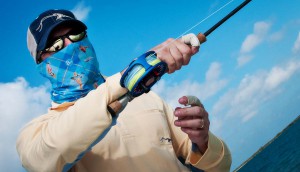 The 8-weight flyrod is standard.
The 8-weight flyrod is standard.
- I also carry a 9-weight for ugly winds and a 7-weight, which I hope to use someday.
- You can get by with just one decent outfit to start with. It’s you that will be holding back your fishing, not your gear.
- But rods do break. Think about having a backup just in case.
- Fast action best … but don’t worry about the precise make and model until your casting gets better than your rod can handle.
- Mine are two Scott Meridians (8 ,9), a Sage Motive (8), and an Orvis Helios 3D (7). All fantastic rods.
- Reels: any decent saltwater reel sized to the rod is fine. The good ones are beauties to fish with. Large arbors are best.
- I have Nautilus, Waterworks-Lamson, Galvan, and the new Orvis Hydros SL (which may be the best reel bargain ever).
- With at least a hundred-fifty yards of backing. 20-pound Dacron is pretty much standard, but the new Hatch backing tests at 68-pounds and is smaller. Gel-spun is tricky. Mono is unacceptable.
- Give the rig a freshwater washdown every day when you come in.
- There is no way to keep sand out of your flats shoes … but socks and gaiters help.
- You won’t need armored flats boots usually, but when you’re wading in rubble, you’ll be really glad you have them. They do fine on the smooth sand flats too.
- I like Simms flats sneakers. The Orvis Andros flats boots are equally protective but a bit more clunky. I have both (I know. I’m a gear junky.).
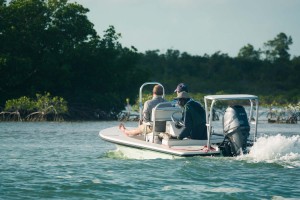 Leaders: do not obsess over leaders. It ain’t a big deal once you get past the basics.
Leaders: do not obsess over leaders. It ain’t a big deal once you get past the basics.
- Mono or fluorocarbon? I prefer FC … but your mileage may vary.
- How long? Nine or ten feet, longer if the fish are spooky (tie on more tippet).
- I put a heavy mono 2.5-foot pigtail at the end of my flyline and loop the leader to it — doesn’t affect the cast/rollover and does add a couple feet to leader length.
- Average bonefish aren’t leader-shy and with a good presentation they should get to the fly before they see the leader.
- There may be a downside to using 15-pound tippet, but I don’t know what it is.
- In the mangroves, go to 20-pound. Ultra-spooky, 12-pound or lighter.
- Too light a leader kills fish. By the time you get them in, they’re really exhausted, and if they don’t die from that, a predator can snap them up easily.
- Check the leader often, replace if frayed. The bonefish won’t do much harm, but the coral and mangroves and the baby barracudas and needlefish will.
- Flylines: weight-forward lines with fat, short bellies are good for a beginner, Rio Quickshooter etc. Tropical of course. Over-lining one weight can be useful, especially for wind.
- The whole relationship between line weight and rod size is an anachronistic leftover from the 1960s. If your line loads the rod well, it’s a tradeoff between casting ease and a potential for more splash.
- Unless you’re certain you’ll never leave the boat and a boat bag is good enough, you need a wading pack of some kind.
- Having carried an excellent hip pack for a year, I decided I liked a sling better.
- Carry flies, leaders and tippet, a snip, a hemostat (I like Rising’s), sunscreen, gooky for your lips, pills if you need them (me, Tylenol always — man, sometimes you get sore out there).
- Carry water!
- A rain jacket.
- Toilet paper.
Flies
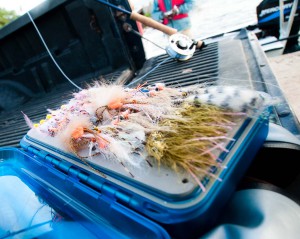 Barbless! Absolutely! You won’t lose fish.
Barbless! Absolutely! You won’t lose fish.- Size 4 and even 2 is right most of the time. You’ll want a few 6s or 8s for really spooky fish.
- I like Grip hooks for fly tying.
- Weighted for water depth, current, wind, etc.
- The fly should sink to the bottom in about three seconds. This means you’ll need mostly beadchain eyes, some lead eyes for deep water and windy days, and a few lights for skinny water and spooky fish.
- I like buggy, impressionistic flies, with legs, not much flash, longer tails/wings. You want the fish to think ‘I don’t know what that is, but it sure looks scrumptious.’
- A lot of tan flies, some beige/white.
- Some darker flies.
- Some with vertically stripes or mottled hue.
- Maybe a spot of pink or orange or red somewhere on the fly.
- Match the color of the bottom. The critters you’re trying to emulate do.
- I always carry some classics: charlies, gotchas, mini-puffs, etc. Dunno why. Tradition maybe. They can be deadly.
- What about weed guards? My tarpon guide calls them ‘fish deflectors.’ Maybe I’m over-thinking it, but the concern that mono weed guards and stalk eyes on shrimp patterns might prevent a hook-up seems legit to me.
- Aaron Adams says:
- “Bigger fish eat bigger things.”
- “Big fish eat a lot of little fish.”
- “And on marl bottoms, worms too.” After listening to Aaron at a club meeting last week, I’ve tied both Borski-worm and San-Juan-worm patterns for my next trip.
- But… Big but. These bonefish guys will usually eat whatever you put in front of them … if you do that right.
Travel
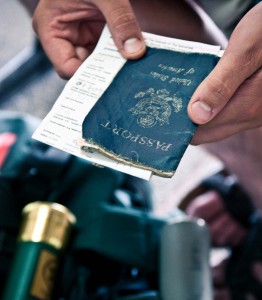 Having travelled a couple million commercial airmiles, two rules:
Having travelled a couple million commercial airmiles, two rules:
- Carry-on only — if you can help it, never check a bag on your way to the fishing.
- Be patient. Relax. You’ll get there.
- The big multi-rod rod cases are super. Fishpond, Orvis, etc.
- Have never had trouble bringing both the carry-on and the rod pack aboard as cabin luggage.
- If there’s medicine you need or you’ll be in trouble, carry extra pills in your pocket. And enough in your carryon to see you through if the trip gets extended by weather or airplane troubles.
- Global Entry (US Customs and Border Protection) is a great program to make travel easier, $100 for five years, includes you TSA-Pre as part of the package. Some premium credit cards pick up the bill.
- Have a copy of your main passport page in your wallet and in every piece of luggage.
- You may be flying on some rickety old airplanes. Relax. Remember that the first person to the scene of an air crash is always the pilot — he’s motivated to fly safely and almost certainly well skilled and experienced on the route he’s flying.
Guides and Lodges
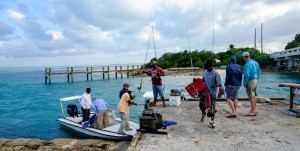 I’ve yet to stay at a bad lodge. Yet to have lousy chow. Yet to have a screwed-up ground connection. Yet to worry about safety or security.
I’ve yet to stay at a bad lodge. Yet to have lousy chow. Yet to have a screwed-up ground connection. Yet to worry about safety or security.
- How fancy they are is reflected in the price. Some border on opulent … but they still chase the same schools of fish.
- WIFI, cell-phone coverage, connectivity: check it out in advance, but usually just fine. Best speed I’ve had was on an island with 200 population — the world is wired.
- New flats boats and motors are a plus. Old ones OK.
- Special needs, let them know in advance.
- Having fished with a dozen guides. They were all smart, decent individuals.
- Ask the guide to give you advice, teach you, tell you when you could do better.
- Try to see what the guide sees when he calls a fish. They usually see the fish first. (But not always! Be alert!)
- It’s considered poor form to stick your fly in the guide’s neck.
- Don’t be a jerk.
- Not a perfect formula, but $100 a day ($50 bucks each for two of you in the boat) is a normal “tip” for the boat (it’s really not a tip, it’s most of the guide’s pay for the day).
- I give them the money when I get in the boat in the morning. Does away with any suspicion that it might be results-based.
- There’ll be a lodge tip at the end of the visit also. Ask the lodge manager what’s normal.
- It’s a cash economy nearly everywhere bonefish are caught. Credit cards just don’t work.
- Remember the submariner’s mantra for going on liberty: Pay double and tip heavy and you’ll always have a good time.
You
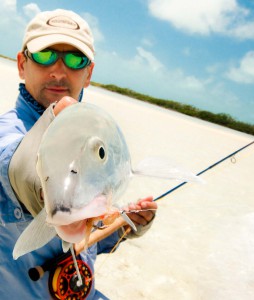 Wear:
Wear:
- A full-cover tropical shirt or pullover or hoody.
- A buff, though I prefer a hoody.
- Sun gloves.
- Long-billed ballcap (I know there are a gazillion kinds of fishing hats, have tried most of them; ballcap is best).
- Quick-dry trousers or shorts … but please read the next entry.
- Do Not Get Sunburned! Armor up. Worry about it. UV penetrates clouds. Anyone who gets burned is an idiot.
- And get in shape. The flats will find muscles you’ve forgotten you had. If you’ve ever needed a good reason for working out, chasing bonefish should do it.
- If you’ve got a trick knee (me: football, hockey, and handball), bring your knee brace. Ditto deal with other physical issues you might have.
- If you need to go slow, go slow.
- And as old submarine skippers teach new ones … if you’re not having fun, you’re not doing it right.
Bonefish and Tarpon Trust
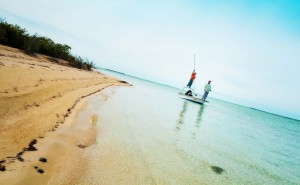 Let me close with a shout-out for the outfit that’s doing tremendous work to make sure our kids and grandkids will be able to catch these incredible fish in their lifetimes: Bonefish and Tarpon Trust.
Let me close with a shout-out for the outfit that’s doing tremendous work to make sure our kids and grandkids will be able to catch these incredible fish in their lifetimes: Bonefish and Tarpon Trust.
- BTT is a fantastic nonprofit dedicated to maintaining and advancing the sport and the fishery for our three slam-species, tarpon, bonefish, and now permit too.
- It has strong leadership and deep pockets, with supporters and board members like Tom Brokaw, Paul Volker, Yvon Chouinard, Stu Apte, and Christopher Buckley, Jr. They push conservation and fund a ton of new science, to significant good effect.
- Led by Dr. Aaron Adams, a super bunch of young scientists are studying the fish and learning things about them never before understood. Aaron himself is a fine fisherman and an innovative fly tier. On his staff are genuine experts defining new knowledge of the fishery.
- I had opportunity to spend three days with Justin Lewis down at Crooked Island earlier this year. He leads BTT’s Bahamas initiative. It was a master’s-level education in bonefish and the flats.
- Inexpensive to join, a slick magazine, and they’ll send you a nice cap. Become a member!
And that’s it, what a beginner thinks beginners might want to know before they become ‘destination fishermen’ chasing the world’s finest gamefish.
Tight lines.
John Byron Gink & Gasoline www.ginkandgasoline.com hookups@ginkandgasoline.com Sign Up For Our Weekly Newsletter!
Sign Up For Our Weekly Newsletter!
John Byron is a retired navy officer. Spent most of his time in submarines. Commanded one of them. Ran the navy operation at Cape Canaveral. He lives in Cocoa Beach. Plans to spend his kids’ inheritance chasing bonefish and tarpon.
I fished with John out of Abaco Lodge last spring and he’ll join the gang at Bair’s Lodge for a couple trips coming up. It was obvious that he’d caught a few fish in his lifetime. Ties some neat flies. But relatively new to bonefish, an average caster, still learning the game.
He’s written A Beginner’s Guide to Catching Bonefish to capture his experience and help out fellow neophytes considering their first bonefish trip.
You want expert advice? Go to the experts. This is for beginners, from one of them. Opinion, yes, but he’ll tell you there’s some scar tissue attached.

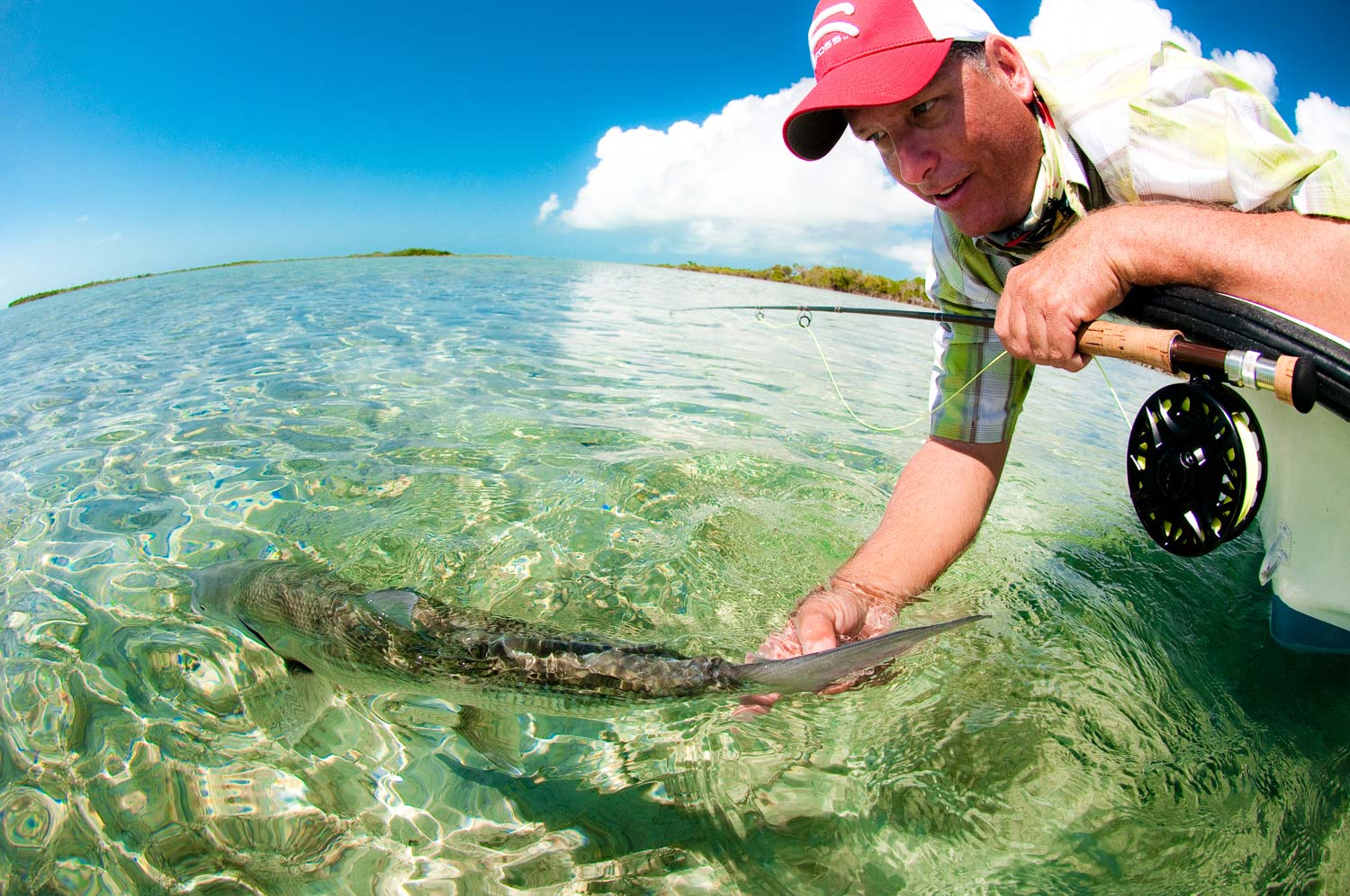
Thanks, John! This is an awesome checklist!! Worth reading twice! Hope to be on a trip soon. And you’re tips will sure come in handy! Cheers Sir! Phil
This is great for all those who fish for bonefish not just beginners. I look forward to a follow up including info and reminders for those who love the chase.
THIS is a simple, fantastic bonefish write-up. Phenomenal.
What an outstanding and succinct introduction to the wonderful wacky world of bonefish. Well done sir.
With the exception of the specific fly and gear recommendations, this is a good primer for anyone traveling to catch any species of fish.
Good summary of the basics and for me, an intermediate flats flyfisher a good reminder of what’s important. Thanks for the conservation stick. I’m a member and support them when I can.
The best bonefishing checklist for a beginner. Having it listed as bullet points made it easier to mentally digest. I am going after bonefish for the first time. This article will be reviewed repeatedly as I get closer and closer to my trip.
Very good indeed, but hard to agree that you’ll catch more fish wading than from a boat. Our experience in the Bahamas is about 4 to 1 the other way – you cover so much more water and can see so much better from a skiff.
Thanks. Great article. Going to Aleuthra in November and practicing as much as I can. Your article is the most comprehensive I have seen
Pingback: Bonefish — Getting into the game | Fly Fishing | Gink and Gasoline | How to Fly Fish | Trout Fishing | Fly Tying | Fly Fishing Blog
Good Morning John
I just tripped over your article beginner’s guide to catching bonefish, what a great read. I was taken by the submarine references and realized I recognized the name. Is there a chance we were shipmates on the 611 in the early 70’s. Respectfully John D. IC3 SS
Guilty. Gun Boss 611-Blue.
Wonderful and witty